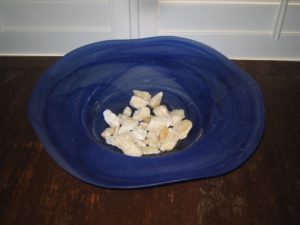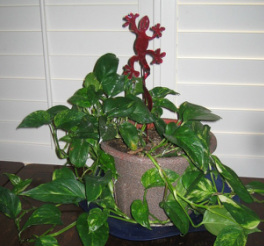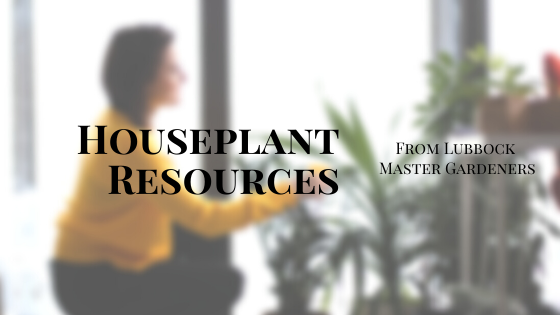Handling Houseplants without Drowning Them
by Charlotte Davidson, Master Gardener
Our thanks to Lubbock’s Golden Gazette for allowing this re-print of an article that appeared in their October 2012 issue.
When you feel those first cool nights. You know. Summer is over and it is time to take those houseplants that have been enjoying our porches and patios – back inside.
In a recent talk to Lubbock Master Gardeners, Jennifer Simek, manager of the Texas Tech Greenhouse and administrator of the Arboretum, said that while our outside plants are suffering from not enough water – we tend to drown our houseplants – killing them with too much H2O and too much salt from our West Texas water.
Here are some tips from her about how to keep those houseplants green and happy both inside and outside of your house.

Always provide drainage for houseplants even in dry Lubbock. They should not sit in a saucer of water. That can cause root rot.
When should you water?
- Always check to see how wet the soil is in the pot.
- When the top 2/3 of the pot gets dry – water.
- Water until the water runs out the bottom of the pot – to leach the salt out.
- Empty the drip plate under the pots. Don’t let the plant sit in water of this could cause root rot.
- Plants that are overwatered or underwatered can look the same! The edges of the leaves will turn brown and leaves may drop off – whether the plant is too wet or too dry.
- You know there is too little water if the soil pulls away from the edges of the pot and the stems of the plant shrivel.
A major problem is too much salt in the water here in Lubbock. So, how can you tell if there is too much salt?
- You get a white ring at the soil line of your pot or around the drainage hole of the pot.
- You get yellow or white cracks in the soil.
- Your plant has brown leaf tips.
- The new growth is small
- To leach out the salt – water with distilled water every fourth time you water.
Here in Lubbock humidity is needed for successful plant growth.
- Mist your plants for humidity – but mist with distilled water.
- Fill a shallow tray with gravel and water and set the pots in it. As the water evaporates it will humidify your houseplants.
- But be careful with humidifiers – too much mist and your walls are wet!
Temperature is also important.
- 70 to 80 degrees is the right temperature for houseplants.
- A small drop in temperature at night is good. it makes the blooms more intense.
- Flowering plants need 60-68 degrees a night for foliage and 50-60 degrees for flowering plants to bloom.
What is the right amount of light?
- Houseplants can get too much light. They can get Sun Scald from being in direct sunlight – that’s when you see white patches on the leaves.
- Too little light – When a plant starts bending toward the light and gets spindly. then it needs more light.
- Flowering plants with lots of growth and a lack of flowers means they are getting too little light.
- The very best lighting for houseplants is 30% incandescent with 70% fluorescent.
What about plant fertilizer?
- For houseplant nutrition, a 20-20-20 fertilizer is best for most houseplants.
- Flowering plants will need phosphorus and potassium twice a month.
- Use a water-soluble or liquid fertilizer added every third or fourth time you water. Sticks and spikes tend to put the fertilizer all in one spot.
What about re-potting when the plants outgrow the pot?
- The question is how large you want the plant to be. Put it in a bigger pot and get a bigger plant. So, go up only one pot size when you replant.
- The best potting soil is just a general well-drained potting mix with peat, perlite and vermiculite to aerate the soil.

Water with distilled water every third or fourth watering. This will leach out the salt from our tap water.
Poisonous Houseplants
“Most poisonous houseplants induce vomiting and cause an upset stomach. For most of them you would have to eat a lot to be fatal, “ Simek said. “Some are just skin irritants.”
Here are the top 12 on the poisonous houseplant list:
1. Aloe Vera
2. English Ivy
3. Rosary Pea
4. Azaleas
5. Chrysanthemums
6. Hydrangeas
7. Poinsettias
8. Mistletoe
9. Philodendrons
10. Amaryllis bulbs
11. Calla Lilies
12. Oleander (highly toxic)
Helpful Houseplants
Our houses are full of acetone, chloroform, ethyl acetate – and the three of major concern: Benzene, trichloroethylene and formaldehyde. These can lead to asthma and allergies.
Here are some plants that absorb the pollutants and scrub and purify the air.
1. Spider Plant,
2. Boston Fern
3. English Ivy
4. Arecas Palm
5. Golden Pothos
6. Aloe Vera
7. Chinese Evergreen
